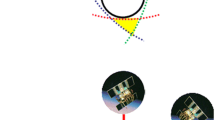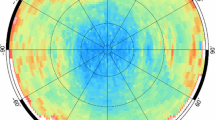Abstract
The NAVSTAR Global Positioning System (GPS) is a satellite based navigation system designed especially for real-time threedimensional position and velocity determination. Real-time performance, however, is, except for navigation purposes, not necessarily required for the majority of the positioning tasks. Post-processing of the recorded raw GPS data is, therefore, the evaluation technique mainly applied, also by utilizing GPS in geodetic disciplines. Numerous investigations in static geodetic positioning (refs. 3, 14, 15) have meanwhile demonstrated a high accuracy potential of the GPS. Relative positioning accuracies in the order of centimetres are typical when using GPS carrier phase observations in the static mode.
Access this chapter
Tax calculation will be finalised at checkout
Purchases are for personal use only
Preview
Unable to display preview. Download preview PDF.
Similar content being viewed by others
References
Ackermann, F. (1984): Utilization of Navigation Data for Aerial Triangulation, IAP, Vol. 25-A3b, Rio de Janeiro
Ackermann, F. (1986): Use of Camera Orientation Data in Photogrammetry — a Review, ISPRS Comm. I Symposium, Stuttgart
Beutler, G., Rothacher, M. (1986): Auswertung der 1984-Alaska-GPS-Kampagne, Schweizerische Zeitschrift für Vermessung, Photogrammetrie, Kulturtechnik, Heft 6, 213–218
Boswinkel, D., Witmer, R., v. d. Vegt, J.W. (1988): Utilization of GPS in large scale photogrammetry, ISPRS Congress Comm. I, Kyoto
Cannon, M.E., Schwarz, K.P., Wong, R.V.C. (1986): Kinematic Positioning with GPS — An Analysis of Road Tests, Fourth International Geodetic Symposium on Satellite Positioning, Austin, Texas
Friess, P. (1986): A Simulation Study on the Improvement of Aerial Triangulation by Navigation Data. ISPRS Comm. I II Symposium, Rovanimi
King, R.W., Masters, E.G., Rizos, C., Stolz, A. (1985): Surveying with GPS, Monograph No. 9, School of Surveying University of New South Wales, Kensington, NSW, Australia
Kleusberg, A. (1986): GPS Positioning Techniques for Moving Sensors, ISPRS Comm. I Symposium, Stuttgart
Lachapelle, G., Lethaby, J., Casey, M. (1985): Airborne Single Point and Differential GPS Navigation for Hydrographie Bathymetry, Hydro- graphic Journal 24, 1–8.
Lindenberger, J. (1988): Modelling Orientation Parameters of Sensor Platforms, ISPRS Congress Comm. I, Kyoto
Mader, G.L. (1986): Dynamic Positioning Using GPS Carrier Phase Measurements, manuscripta geodaetica Heft 11, 272–277
Mader, G.L., Carter, W.E., Douglas, B.C. (1986): Decimeter Precision Aircraft Positioning Using GPS Carrier Phase Measurements, Geodetic Research and Development Laboratory, Rockville U.S.A.
Nagel, E. (1976): Die Bezugssysteme der Satellitengeodäsie, Dissertation, Publication of the German Geodetic Commission ( DGK ), Series C No. 223
Proceedings of the First International Symposium on Positioning with GPS (1985) Rockville, Md. April 15–19
Remondi, B.W. (1984): Using the Global Positioning System (GPS) Phase Observable for Relative Geodesy: Modeling, Processing and Results, Ph. D. Thesis, Center for Space Research, The University of Texas at Austin, CSR-84-2
Remondi, B.W. (1985): Performing Centimeter-Level Surveys in Seconds with GPS Carrier Phase: Initial Results, Global Positioning Papers published in Navigation Vol. III, The Institute of Navigation, Washington D.C.
Wells D.E., Ed., (1986): Guide to GPS positioning, Canadian GPS Associates Fredericton,N.B.
Author information
Authors and Affiliations
Editor information
Editors and Affiliations
Rights and permissions
Copyright information
© 1989 Springer-Verlag Berlin Heidelberg
About this paper
Cite this paper
Friess, P. (1989). Empirical Accuracy of Positions Computed from Airborne GPS Data. In: Linkwitz, K., Hangleiter, U. (eds) High Precision Navigation. Springer, Berlin, Heidelberg. https://doi.org/10.1007/978-3-642-74585-0_10
Download citation
DOI: https://doi.org/10.1007/978-3-642-74585-0_10
Publisher Name: Springer, Berlin, Heidelberg
Print ISBN: 978-3-642-74587-4
Online ISBN: 978-3-642-74585-0
eBook Packages: Springer Book Archive




